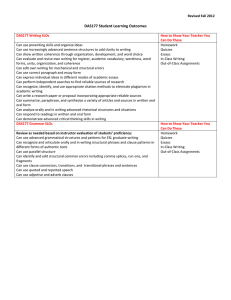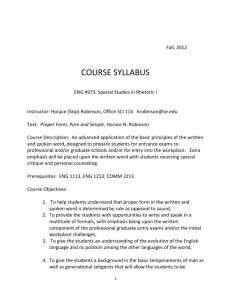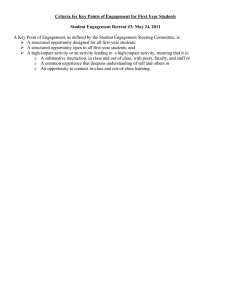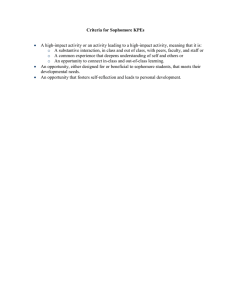Materials Development in Three Italian CALL Projects: Seeking an
advertisement
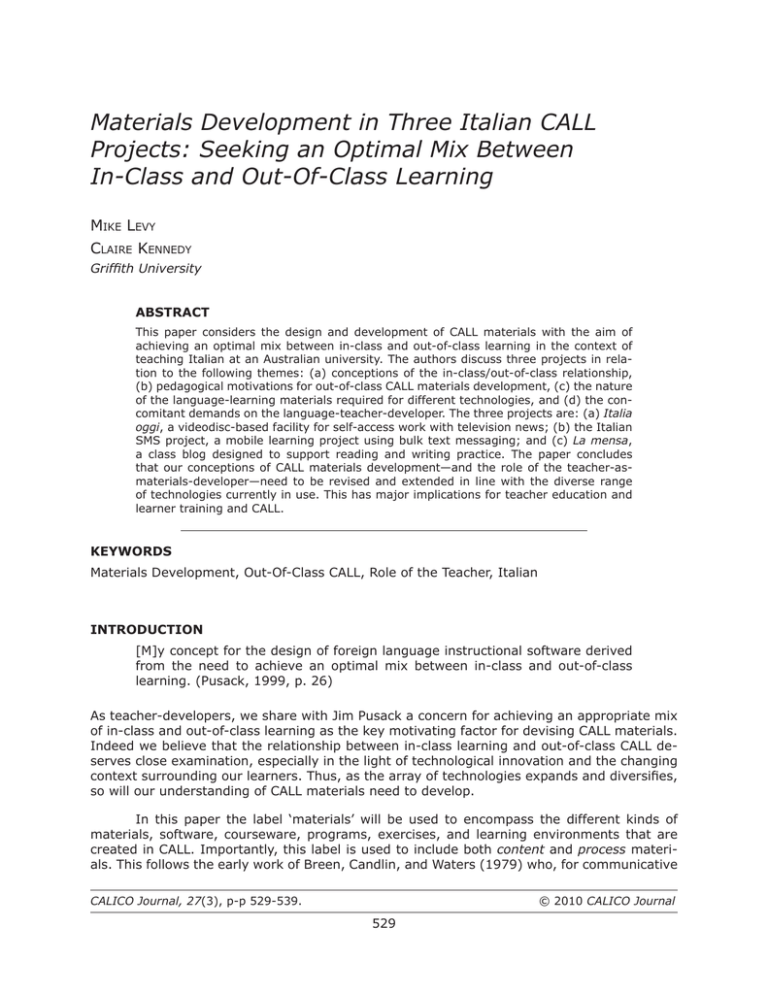
CALICO Journal, 27(3) Mike Levy and Claire Kennedy Materials Development in Three Italian CALL Projects: Seeking an Optimal Mix Between In-Class and Out-Of-Class Learning Mike Levy Claire Kennedy Griffith University ABSTRACT This paper considers the design and development of CALL materials with the aim of achieving an optimal mix between in-class and out-of-class learning in the context of teaching Italian at an Australian university. The authors discuss three projects in relation to the following themes: (a) conceptions of the in-class/out-of-class relationship, (b) pedagogical motivations for out-of-class CALL materials development, (c) the nature of the language-learning materials required for different technologies, and (d) the concomitant demands on the language-teacher-developer. The three projects are: (a) Italia oggi, a videodisc-based facility for self-access work with television news; (b) the Italian SMS project, a mobile learning project using bulk text messaging; and (c) La mensa, a class blog designed to support reading and writing practice. The paper concludes that our conceptions of CALL materials development—and the role of the teacher-asmaterials-developer—need to be revised and extended in line with the diverse range of technologies currently in use. This has major implications for teacher education and learner training and CALL. KEYWORDS Materials Development, Out-Of-Class CALL, Role of the Teacher, Italian INTRODUCTION [M]y concept for the design of foreign language instructional software derived from the need to achieve an optimal mix between in-class and out-of-class learning. (Pusack, 1999, p. 26) As teacher-developers, we share with Jim Pusack a concern for achieving an appropriate mix of in-class and out-of-class learning as the key motivating factor for devising CALL materials. Indeed we believe that the relationship between in-class learning and out-of-class CALL deserves close examination, especially in the light of technological innovation and the changing context surrounding our learners. Thus, as the array of technologies expands and diversifies, so will our understanding of CALL materials need to develop. In this paper the label ‘materials’ will be used to encompass the different kinds of materials, software, courseware, programs, exercises, and learning environments that are created in CALL. Importantly, this label is used to include both content and process materials. This follows the early work of Breen, Candlin, and Waters (1979) who, for communicative CALICO Journal, 27(3), p-p 529-539. © 2010 CALICO Journal 529 CALICO Journal, 27(3) Materials Development in Three Italian CALL Projects language teaching, suggested the development of two kinds of materials: content materials as sources of data and information and process materials to serve as “guidelines or frameworks for the learners’ use of communicative knowledge and abilities” (p. 5). This general framework for our understanding of CALL materials is helpful particularly now, when we need to expand our conception of CALL materials, not only because of the increasing number of technologies that are now in use, but also because of a diversity of function that reaches well beyond the conventional computer tutor. For example, developing CALL materials using Web 2.0 technologies such as blogs and wikis is very much concerned with structuring and activating a process. Such CALL process materials segment, mediate, and help manage—both implicitly and explicitly—the interactions between students, teachers, and the computer in different ways from earlier approaches. In the early days of CALL, it was considerably easier to draw a line between in-class and out-of-class work than now. Typically, out-of-class materials would be available in the form of software preloaded onto computers in the computer laboratory or delivered a little more flexibly through a floppy disk, CD, or videodisc containing teacher-developed or commercial, third-party materials. Again, typically, the technologies were available to the language learners only outside the classroom, and the content tended to be separate from the work in the class, especially, of course, with third-party developed materials. Today, the in-class/out-of-class relationship is much more fluid and complex. For example, computers are often available within classrooms. Learners may access the internet in class, just as they would from the library or from home. The number of technologies and applications available for language learning has grown enormously, especially in the area of computer-mediated communication, so that the options for interactions of various kinds are numerous. Meanwhile, teacher and learner expertise in new technologies is very high compared to earlier times. These developments lead to new and different conceptions of the inclass/out-of-class relationship, both in terms of teacher roles and materials development. With these ideas in mind, this paper discusses three CALL development projects for Italian conducted at a university in Australia by the Italian staff and their collaborators.1 The earliest project entailed the creation of a special-purpose database of materials and its application in the Italian program: Italia oggi ‘Italy Today,’ a videodisc-based facility for self-access work using television news material and with a particular focus on listening (Kennedy, Miceli, & Visocnik Murray, 1995; Miceli & Kennedy, 2000). The two more recent projects have applied generic communications tools: in the SMS project, bulk text-messaging services are used to send students regular short bursts of language with a particular focus on supporting vocabulary learning (Levy & Kennedy, 2005; Kennedy & Levy, 2008), and La mensa ‘The Refectory’ is a class blog designed to support writing and reading practice (Miceli & Visocnik Murray, 2008). In the description of the three Italian projects, we examine the relationship between out-of-class CALL and in-class work in the design of each project and the implications for materials development and the teacher’s role. The language-learning materials required are different from one project to the next, due especially to the affordances of the particular technology involved. These differences in turn lead to and necessitate different skills and abilities from the language-teacher-developer. Four themes, which we regard as pivotal in the implementation of out-of-class CALL, are discussed with each project, as follows: 1. conceptions of the in-class/out-of-class relationship, 2. pedagogical motivations for out-of-class CALL materials development, 530 CALICO Journal, 27(3) Mike Levy and Claire Kennedy 3. the nature of the language-learning materials required for different technologies, and 4. the concomitant demands on the language-teacher-developer. In examining first the team’s overall approach to designing out-of-class CALL and then the issues surrounding materials development in each case, the paper also highlights the centrality of the teacher in implementing CALL and in developing CALL materials. THE PROJECTS Italia oggi ‘Italy Today’—a Self-Access Facility for Exploring Italian Television News The oldest of the projects, Italia oggi, conceived in 1994, was primarily concerned with extending class work at third-year level on exploring television news and current affairs material and focused on listening skills and strategies. Students found such material difficult to work with—being produced for an audience with native-speaker linguistic and sociocultural competence—and were reluctant to tackle it on their own, even though they appreciated its usefulness to them and the abundant recorded material made available to them. To help them practice effectively with this material outside class, we2 transferred selected items to videodisc and used a Macintosh-Hypercard platform to control playback and present a worksheet of activities on each video item. Key to the design of Italia oggi as a self-access facility was our attention to the method with which we wanted the students to handle the material: we sought to make it as effective as possible by carrying over the pedagogic approach used in class. There were three aspects to this. First, we employed the kind of approach to working with authentic material in general that we used in class work: we designed a three-phase worksheet taking students first through basic comprehension, treating the text as a whole; then focusing on lexical, morphosyntactic, and stylistic analysis of its parts to investigate how its meaning was constructed; and finally expanding the view again for an exploration of its sociocultural context. Second, we adopted the approach used in class work on listening material in particular, with its emphasis on strategies: we encouraged the students to work in pairs as well as alone; to watch and discuss the full video item several times before proceeding to intensive, analytical work on its parts; and to use all resources at their disposal both on the computer and in the accompanying library of reference books and newspaper articles on related themes. In line with this we set up a dedicated Italia oggi workstation in a small private-practice room. Third, we sought to design the user interface from a learner-centered rather than a technocentric perspective in order to encourage the students to transfer appropriate habits from classroom work to the computer workstation. We did not present Italia oggi to the students as ‘interactive’ in the sense of being capable of interpreting their input or controlling their actions, but as an assistant that could present activities in an appropriate order and be asked for help at any time, in the form of hints, replay of relevant segments of video, and possible answers. Also essential to the concept of Italia oggi was the provision of a different environment from the one-size-fits-all class environment. The materials could be exploited by students working in pairs or individually at their own pace and in their own time. Indeed, the evaluation 531 CALICO Journal, 27(3) Materials Development in Three Italian CALL Projects processes showed students appreciated Italia oggi especially because it allowed them to work on listening comprehension relatively free of the anxiety—and demoralizing sense of being out of their depth—that was often felt in class, especially at third-year level when dealing with the rapid delivery and often peculiar sentence structure of television news. Not only was their confidence boosted, but they were aware of getting much more out of this type of material. Materials development was at the center of the Italia oggi project, linking the key design decisions regarding the worksheet approach, workstation setup, student training, and integration into courses. The key components of the major, upfront phase of creating the facility were: (a) the definition of a set of worksheet activity types and their functionality, (b) the creation of template cards in Hypercard for the worksheet structure and each activity type, (c) the collection and selection of video items and relevant newspaper and magazine material on related themes (d) the detailed design of worksheet activities for each video item and identification of video segments to link to each activity or question within it, (e) the implementation of those activities using the templates, and finally (f) thorough testing. Following this creation phase, there was also a significant ongoing type of materials development: the work by the teacher of a third-year course to effectively integrate Italia oggi into the course. The course was officially defined as requiring students to spend at least 2 hours per week working with Italia oggi as well as participating in 3 hours of class. The teacher ran a short training session for students at the start of the course, largely concerned with our recommendations on how they should use it and why. She also prepared a recommended minimum program of Italia oggi units to be completed by certain dates in the semester and worksheet tasks to be handed in for assessment on a weekly or fortnightly basis. Through this scheduling of the out-of-class Italia oggi program to complement the program of topics dealt with in class, through the choice and design of class activities drawing on the Italia oggi work in appropriate and imaginative ways, and through appropriate feedback on the Italia oggi activities handed in for assessment, the teacher always sought to ensure that the students perceived continuity between their work done out-of-class with Italia oggi and what they were doing in class, that their work with Italia oggi was recognized and received useful feedback, and that the combination of Italia oggi and in-class work was helping them progress towards the listening comprehension test at the end of the course. The SMS Project The SMS (called instant messaging in the US) project was conceived in 2004, 10 years after Italia oggi, in order to take advantage of new communications technologies (phone text messaging and the internet) that were practically unheard of at Italia oggi’s birth. In common with the Italia oggi project, both the overall design and the approach taken to materials development again reflected our focus on achieving an optimal relationship between out-of-class CALL and in-class work. Our departure point was the expectation that this short-message technology (limited to 160 characters in Australia), which is part of our students’ everyday lives, could be exploited to extend vocabulary practice outside class in frequent short bursts. By sending regular text messages we aimed to help students take advantage of available moments (such as riding on a bus or waiting for a class) by drawing their attention to words, triggering lexical processing in various ways, providing repeated encounters in different contexts of use, and prompting recall for comprehension and production: These varied activities are all recognized as key processes in vocabulary learning (Nation, 2001). Providing a different learning environment from that of class was essential to the rationale for this project. It was a form of mobile learning in that, from the students’ point of view, 532 CALICO Journal, 27(3) Mike Levy and Claire Kennedy messages could arrive ‘any time, any place’ and be processed either then and there or later and elsewhere. The learning environment was also novel in the way it aimed at “horizontal integration” (Levy & Stockwell, 2006) nature, of piggy-backing language-learning experiences onto the students’ everyday use of communications technology in their personal lives. Indeed, this stands in contrast to our classroom practice of requiring students to switch off their phones to concentrate on learning. We sought to take advantage of this novel environment to support students’ motivation by promoting their enjoyment of snippets of language and confidence in their ability to understand them. And indeed, the evaluation processes suggested that many students perceived the benefits explicitly or implicitly in terms of motivation, as they described the messages as entertaining, encouraging them to go over language points outside usual study time, a good way to remember things, useful reminders, or helping them keep on task between classes. Also fundamental to the design in this project was our attention to students’ development as independent learners. We considered SMS especially appropriate in our beginners’ course to help lay a solid foundation for their language-learning experience by cultivating the habit of daily practice and promoting their development of personal language-learning strategies. By devising appropriate content consistent with the course curriculum and by virtue of the medium (providing communication in Italian to be dealt with independently of teachers), we expected the messages to stimulate students’ use of vocabulary learning strategies— particularly determination strategies for discovering the meaning of new words and memory strategies and cognitive strategies for consolidating command of words. In this project, materials development entailed composing messages and scheduling them for specific dates and times by entering the details through the online form provided by a bulk messaging service. The synchronizing of message content to delivery date and time was crucial because the messages needed to be designed around the course content at a very detailed level. There was no user training required, nor any development of tools. We adopted different approaches to message content in two phases of the project, one phase conducted in a third-year course and the other in a beginners’ course. The different approaches reflected the different aims of the courses and approaches to vocabulary acquisition in them. The third-year course was content based, centered on the reading of novels, and had a fairly open curriculum with no preset vocabulary to be acquired. Here the messages sought to draw the students’ attention to aspects of the rich vocabulary encountered in the novel they were studying. They had various objectives, including to aid in comprehension of some sentences or passages; to help in textual analysis by drawing attention to words that provide clues to themes, characterization or settings; to help in recognizing and appreciating figurative usage, idiomatic expressions, and the composition of words from their parts or the relationships between words with shared roots. The beginners’ course, on the other hand, had a fairly closed curriculum linked to a textbook. From the largely predetermined vocabulary introduced in classes each week, we identified words, set phrases, and grammatical points that particularly lent themselves to being reinforced through the messages. When messages included ‘new’ words, it was to encourage use of determination strategies. In this situation, the challenge in preparing messages lay not in selecting the material but varying the ways of presenting it to students (making a suggestion, asking a question, or setting a task—for example, a puzzle to solve or a matching, pairing, multiple choice, ranking, or odd-one-out activity), according to whether we hoped to make them think hard, amuse them, arouse their curiosity, or prompt them to look something up. 533 CALICO Journal, 27(3) Materials Development in Three Italian CALL Projects One of the benefits of the technology and the approach to using it is that the teacher could do much of the message preparation before the course began on the basis of the course plan (the pages of the novel to be discussed each week or the language points to be dealt with in the first-year classes). However, she constantly updated the message schedule throughout the semester, modifying and adding messages in reaction to discussions in class, student queries, or submitted work which suggested specific areas of vocabulary warranted further attention. Furthermore, she increasingly added spontaneous messages that were not about vocabulary but rather on current events, course deadlines, and notices about other potential out-of-class learning activities such as television programs or Italian community events, which were particularly popular with the students. Though the messages were short, we found remarkable both the effort that went into creating them (to make them relevant, interesting, timely and succinct—“meaty bites of language,” as one student put it) and the amount of learning activity some students got out of them. While some students treated the messages as designed for instant consumption and deletion, as we had intended, many saved them for rereading and processing when they could give them what they saw as the necessary attention, which might include writing words down in their notebooks, looking words up in dictionaries and grammar books, and reviewing the relevant pages of the novel or textbook. Given that we had not encouraged replying, it was interesting to discover that many of the beginners wanted to reply, especially when a message set a task and they wanted to try out answers on someone. Those who did so evidently enjoyed engaging in a private SMS exchange with the teacher and often used the opportunity to seek feedback on their message. This also fed into the teacher’s ongoing updating of the message schedule. La mensa ‘the Refectory’—A Class Blog In the youngest of the three projects, the class blog La mensa was developed in 2007 by two colleagues (Miceli & Visocnik Murray, 2008) as an integral part of a third-year course, “Italy through Food.” The course was designed for the sixth and final semester of the Italian program. The restriction to 3 hours of class per week, always very pressing, becomes extremely so at this stage because the students’ capabilities in terms of both content and language proficiency mean that class discussion flourishes but is consistently cut short. In the rationale for La mensa, alongside the aim of extending class by providing an arena for further practice of writing and reading skills, lay the equally important aim of providing a forum for sharing of information, opinions, personal reflections, and analysis that appeals as an alternative to that of class. While still an environment for collective work, the blog environment differs from the class environment in being online and written rather than face-to-face and oral and involving asynchronous communication rather than communication restricted in time and place. Various studies have shown that in such an environment some students are more at ease and more inclined to contribute to discussion than in the classroom. The asynchronous, written nature of blogs can appeal to those who prefer to be sure of what they want to say and how to express it in the target language before saying it, who struggle to get a word in in class, or dislike being interrupted, and the lack of face-to-face communication can reduce some students’ anxiety and shyness (see Ducate & Lomicka, 2008; Fellner & Apple, 2006). La mensa was an out-of-class CALL component of a course designed at the same time as the course and was an integral part of the course content, teaching methods and assessment. The students’ participation in the blog was assessed in terms of frequency of contribution and substance of content, but not accuracy or complexity of language. Each student was expected to make two major thread-initiating posts during the semester and also to comment 534 CALICO Journal, 27(3) Mike Levy and Claire Kennedy on a regular basis in other threads initiated by other students and the teachers on various specific themes relating to class discussions. Only a small amount of class time was needed to provide basic training in using the blog tool and showing the students around the various sections. The materials development by the teachers included an initial phase of design and creation of the various sections of the blog and an ongoing phase of monitoring and participation throughout its lifetime. The design decisions were aimed at ensuring that the blog would support a sense of collective engagement around the course themes. These decisions concerned the structure, the links made available, the images, and the recommendations on the purpose and themes of the student-initiated threads. The teachers’ role continued during the semester through both the regular weekly initiation of threads for continuation of the discussion held in class and occasional interventions in the discussions among students once they were under way. Such interventions included responding to a student’s point when no other students had, for example, or highlighting a connection and posing a question which encouraged students to continue a thread in a new direction. In this project, therefore, ‘materials development’ primarily had a process orientation, providing, especially in the initial stages, a guideline or framework for language development and use, as opposed to the content orientation of the other two projects. The teachers’ design and implementation of La mensa focused on facilitating the process of students’ creation of material in the target language and involved not only the processes devised within the blog itself—through the provision of links to authentic materials (e.g., recipes)—but also the links and pathways built between the in-class and out-of-class activities through which the students could collaborate and produce informal writing. Process issues that needed to be addressed included protocols for submitting contributions and comments, a monitoring and moderating strategy for the teachers, and an understanding of how student contributions would be assessed (S. Visocnik Murray, personal communication, June, 2008). All in all, the process of development of these materials, their integration into the course through regular in-class activities and assessment, and many other aspects of the blog required an intricate and detailed understanding of the in-class/out-of-class relationship. From the teacher-as-materials-developer perspective, the blog had to be created and managed in systematic and complex ways. It also required a sustained commitment week by week, by both the teachers and students, to operate successfully. However, such is the power and penetration of the blog and the processes that are generated by such technology-aware teachers that, on completion of this course, the teachers reached the conclusion that it simply could not have been conceived without the blog (S. Visocnik Murray, personal communication, June, 2008). THE CONCEPTION OF OUT-OF-CLASS CALL IN A TERTIARY ITALIAN PROGRAM Each of the projects discussed in this paper has involved an application of technology designed to help students in a specific course make effective use of out-of-class time. The focus on out-of-class rather than in-class CALL reflects the fact that in a university environment such as ours only a small proportion of the students’ weekly language practice time is spent in class: the expectation for a course in our department is normally 3 contact hours plus 7 hours of private practice per week. The team members share the conviction that the short, precious class time needs to be exploited as much as possible for face-to-face communication in the language and that it is essential to guide the students in making the most of out-of-class practice time because most students have few opportunities for face-to-face contact with native 535 CALICO Journal, 27(3) Materials Development in Three Italian CALL Projects speakers. Furthermore, since the students are adults, considerable demands can be placed on them regarding what they do in out-of-class practice, and they can be counted on both to seek assistance when necessary and to provide useful feedback on the effectiveness of the activities that teachers propose. Through the 15 years of CALL projects, what has remained constant has been the team’s focus on that relationship between out-of-class CALL and the in-class work. The team’s overall perspective is one that sees the benefits of out-of-class CALL in three types of potential that lie in the relationship between out-of-class CALL and in-class work. First, out-of-class CALL allows for an extension of class into out-of-class time in the sense of providing for extra time on task beyond what is possible in the limited class time, especially extra practice in macroskills, vocabulary and grammar, and extra contact with appropriate material for exploring linguistic and cultural content. This has been increasingly important in recent years as class sizes have increased and contact hours decreased. Second, out-of-class CALL can provide an environment different from class in various ways that may suit individual students’ preferences and give them flexibility. The environment may be different in many ways: it may contrast with the face-to-face character of class, be personalized (as opposed to the one-size-fits-all nature of class), or be mobile in time and space. Thus, the out-of-class CALL environment may be one that allows students to relate differently to each other (and possibly the teachers), such as in an online community, or to work at their own pace in places and times that suit their lifestyle. This aspect of the in-class/out-of-class CALL relationship is very important with respect to supporting students’ motivation—how they feel about their learning, their confidence and their sense of progress. Third, out-of-class CALL, like any teacherguided out-of-class work, can be a half-way house for developing independent learners: halfway between in-class work in which the teacher’s support is immediate and face-to-face and fully self-directed language-learning experience in which the teacher’s support is radically reduced or virtually nonexistent. So, out-of-class CALL can be exploited to develop students’ language-learning strategies, guiding them in applying and honing such strategies. This has benefits not only in the context of formal studies but also after the conclusion of studies; it is, therefore, an investment in the students’ lifelong learning. Conceiving of out-of-class CALL in this way has important implications for CALL design and the role of the teachers. The Italian team’s use of out-of-class CALL is always designed for a specific course and fully integrated into it. Each CALL project is aimed at drawing on all three types of relationship between out-of-class CALL and in-class work in the design: increasing the teachers’ influence over the students’ agenda for out-of-class time in relation to the course, increasing flexibility for the students by providing a different kind of environment to that of class, and contributing to their development as independent learners. Designs that take advantage of each of these three aspects of the potential relationship between out-ofclass CALL and in-class work can be seen to support the four key goals of the Italian teaching program: (a) developing language skills; (b) providing access to material, especially authentic material; (c) developing learning strategies; and (d) sustaining motivation. Each project is devised with the expectation that out-of-class CALL will extend and increase the active role of teachers in the course, not decrease their role. The teachers need to be active not just in setting up CALL resources or tools and making them available to the students, but in managing their integration in the course to ensure that the relationship between out-of-class CALL and in-class activities work. Materials development includes not only selecting materials and preparing activities and instructions in the traditional sense, but also training (often more concerned with the instructional purpose of CALL than the technical operation) and ongoing participation in student’s interaction during the process. 536 CALICO Journal, 27(3) Mike Levy and Claire Kennedy CONCLUSION The materials development landscape is marked now by its range and diversity. The reasons are many, but two key factors most certainly arise: (a) the increasing number of generic technologies available which can be used to facilitate and encourage interaction between the teacher and students and among students themselves across the in-class/out-of-class divide and (b) students’ and teachers’ increased proficiency in the use of the technologies. These two factors have meant that we now have the means and the skills to enhance and perhaps intensify the in-class/out-of-class relationship. However, in spite of all this, we are still seeking the optimal in-class/out-of-class mix. This still is, and perhaps always will be, a work in progress because, as Jim Pusack and his colleagues pointed out many years ago (Hope, Taylor & Pusack, 1984), ultimately it all depends upon the teacher. Without the pivotal role played by the language teacher in developing CALL materials and orchestrating their implementation, the potential of an engaging, powerful language-learning environment breaks down. The demands on the teacher are becoming even more intensive compared with the early days of CALL, partly because the expectations of the student body are now much more sophisticated and demanding. Clearly this has significant implications for teacher education and CALL. But these issues do not only concern the teacher per se. They also invoke the need for a rich institutional and technical support structure, and also learner training so that learners can distinguish between using generic technologies for learning as opposed to social purposes. Although, again, much learner training may come back to the work of the language teacher in class, perhaps there are avenues for increased learner training to be conducted through tutorial software out of class, in larger groups beyond the individual class, or even across language-learning programs. These factors are particularly important if we wish to avoid the novelty trap in CALL and want the student experience to be engaging and sustained over the long term. In all of this, still, locating the ideal in-class/and out-of-class mix and the teacher’s role are critical. NOTES One of the authors is one of the three Italian team members, the other author is the key collaborator. 1 The personal pronouns ‘we,’ ‘our,’ and ‘us,’ when used in discussion of any specific project in the remainder of this paper, refer to the team members involved in that project: Kennedy, Miceli, and Visocnik Murray for Italia oggi, Levy and Kennedy for the SMS project, and Miceli and Visocnik Murray for La mensa. 2 537 CALICO Journal, 27(3) Materials Development in Three Italian CALL Projects REFERENCES Breen, M. P., Candlin, C. N., & Waters, A. (1979). Communicative materials design: Some basic principles. RELC Journal, 10, 1-13. Ducate L., & Lomicka, L. (2008). Adventures in the blogosphere: From blog readers to blog writers. Computer Assisted Language Learning, 21, 9-28. Fellner, T., & Apple, M. (2006). Developing writing fluency and lexical complexity with blogs. The JALT CALL Journal, 2, 15-26. Hope, G. R., Taylor, H. F., & Pusack, J. P. (1984). Using computers in teaching foreign languages. Englewood Cliffs, NJ: Prentice Hall Regents. Kennedy, C., & Levy, M. (2008). L’italiano al telefonino: Using SMS to support beginners’ language learning. ReCALL, 20, 315-330. Kennedy, C., Miceli, T., & Visocnik Murray, S. (1995). Italia oggi: A multimedia window on contemporary Italy. On-CALL, 9(2), 2-10. Levy, M., & Kennedy, C. (2005). Learning Italian via mobile SMS. In A. Kukulska-Hulme & J. Traxler (Eds.), Mobile learning: A handbook for educators and trainers. London: Routledge. Levy, M., & Stockwell, G. (2006). CALL dimensions: Options and issues in computer assisted language learning. Mahwah, NJ: Lawrence Erlbaum & Associates. Miceli, T., & Kennedy, C. (2000). CALL in a communicative context: A study of students’ conversation at a multimedia workstation. Babel, 35, 18-23. Miceli, T., & Visocnik Murray, S. (2008, October). What’s cooking: Language, food and blogs in the foreign language classroom. Paper presented at the conference of the Modern Language Teachers’ Association of Queensland, “Languages Matter,” Gold Coast, Australia. Nation, I. S. P. (2001). Learning vocabulary in another language. Cambridge: Cambridge University Press. Pusack, J. P. (1999). The Kontakte multimedia project at the University of Iowa. CALICO Journal, 17, 25-42. AUTHORS’ BIODATA Mike Levy is Professor of Applied Linguistics and Head of the School of Languages and Linguistics at Griffith University. His research includes studies on the role of technology in language learning, teacher education and learner training, mobile learning for Italian, and distance education for Mandarin Chinese. His publications include CALL Dimensions with Glenn Stockwell (Erlbaum, 2006) and Teacher Education in CALL with Philip Hubbard (Benjamins, 2006). He is also Chair of the Conference Planning Committee for WorldCALL (http://www.worldcall.org). Claire Kennedy is Cassamarca Senior Lecturer in Italian Studies at Griffith University. She has been conducting research in CALL for 15 years and is codeveloper of several CALL resources for tertiary Italian learners. 538 CALICO Journal, 27(3) Mike Levy and Claire Kennedy AUTHORS’ ADDRESS Mike Levy School of Languages and Linguistics Griffith University Nathan QLD 4111 Australia Phone:+61 7 3735 7525 Fax: +61 7 3735 6766 Email:michael.levy@griffith.edu.au Claire Kennedy School of Languages and Linguistics Griffith University Nathan QLD 4111 Australia Phone:+61 7 3735 7141 Fax: +61 7 3735 6766 Email:c.kennedy@griffith.edu.au 539
